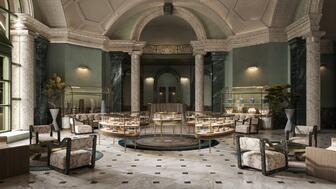The couple pleaded guilty to concealing at least $127 million in cash transactions at its precious metals businesses.
HRD Antwerp Is Now Grading Lab-Grown Diamonds Like Natural
The laboratory has started grading man-made diamonds using the same color and clarity scales it applies to mined stones.

Antwerp—HRD Antwerp is now grading lab-grown diamonds using the same color and clarity scales it applies to natural stones, the laboratory confirmed to National Jeweler.
In its new man-made grading reports, which launched last week, HRD Antwerp has migrated from having just five color grades—colorless, near colorless, faint, very light and light—to the same 13 that it uses for natural diamonds—D to M, plus N-O, P-R and S-Z.
The Belgian grading lab is also switching from five clarity grades—free of inclusions (FI) to included (I)—to the same 10 applied to mined diamonds, starting with loupe clean (LC) and ranging to P3 (pique 3).
“Our aim is to serve the industry as a whole, from rough to consumers. We identified a need for better transparency and support concerning the new complications [meaning undisclosed mixing of lab-grown diamonds with natural] that arise with lab-grown diamonds,” the lab said in a statement to National Jeweler. “For this reason, we developed the set of measures explained above. The certification is just one piece of the complete puzzle of services we provide to enhance trust and transparency.”
HRD Antwerp has been issuing grading reports for lab-grown diamonds since 2013.
In the fall, it plans to add a report for finished pieces of jewelry set with man-made stones (the lab already issues reports for jewelry set with natural stones.)
The issue of how to grade lab-grown diamonds is a source of disagreement in the trade.
In October 2016, National Jeweler talked to Tom Moses, the Gemological Institute of America’s executive vice president and chief laboratory and research officer, about why the GIA uses a limited, less specific grading scale in its “Synthetic Diamond Reports” instead of the four Cs.
In the interview, Moses said that generally speaking, lab-grown diamonds are nitrogen-poor, so they are going to be of high color and clarity and not exhibit the same range of color and clarity as mined diamonds.
The GIA’s grading system, which was created long before lab-grown diamonds were prevalent, was “developed for normal mine run, which doesn’t change,” he said. “That’s nature.”
Moses’ remarks generated some back-and-forth in the story’s comments section, and a more recent editorial by JCK News Director Rob Bates—who thinks the GIA should offer the standard 4Cs scale for lab-grown diamonds—sparked a slew of online conversation over the grading of lab-grown diamonds.
Moses said in the October 2016 interview with National Jeweler
GIA spokesman Stephen Morisseau told National Jeweler last week that it will be launching new reports for man-made diamonds “in the near future,” though details on exactly what will be changing beyond the title—the FTC now says that the term “synthetic” is confusing to consumers—have not been released.
The Latest

Consumers shared concerns about prices, inflation, tariffs, trade, and politics in the survey’s write-in response section.

In February 2026, the auction house will move its headquarters to the former Steinway Hall, a neoclassical landmark on Billionaires’ Row.

How Jewelers of America’s 20 Under 40 are leading to ensure a brighter future for the jewelry industry.

The new show will take place Jan. 23-25, 2026.


The former BHP Billiton leader and Gemfields chairman is remembered for his influential leadership throughout his 50-year mining career.

The LVMH-owned brand has partnered with the costume design union to revamp its award for 2026.

Roseco’s 704-page catalog showcases new lab-grown diamonds, findings, tools & more—available in print or interactive digital editions.

The luxury titan inked a deal to acquire an initial minority stake in the jewelry manufacturer with a pathway to full ownership by 2032.

The company’s curation of unsigned vintage and estate jewelry debuted at the Bloomingdale’s in Costa Mesa, California.

In the recent multi-shipment seizure, CBP also found counterfeit Audemars Piguet, Moncler, and Chrome Hearts items.

Helzberg’s Chief Retail Officer Mitch Maggart shared details about its tests of a new store concept rooted in an elevated luxury experience.

Jewelers of America execs and National Jeweler editors discuss tariffs, the sky-high gold price, and the engagement that broke the internet.

The luxury goods company said founder Ippolita Rostagno will remain at the brand’s helm.

Laura Burdese, who joined the Italian luxury brand in 2022, will take on the role in July.

The National Jeweler editors revisit the most noteworthy industry happenings and design trends from 2025.

Need a gift for the cat lover who has everything? Look no further than our latest Piece of the Week.

It purchased the “Grosse Pièce,” an ultra-complicated Audemars Piguet pocket watch from the ‘20s, for a record-breaking price at Sotheby’s.

The lab-grown diamond grower now offers custom engagement and fashion jewelry through its Kira Custom Lab Jewelry service.

Chandler got his start at Michelson Jewelers and has served as DCA president and CEO since 2001. He will retire at the end of the month.

The boutique is slated to open this week inside Terminal 8, offering pre-owned Rolex watches and more to international travelers.

Sponsored by Digital Monitoring Products

The special-edition egg pendant ingested in a New Zealand jewelry store was recovered after a six-day wait.

Associate Editor Natalie Francisco plays favorites with Piece of the Week, selecting a standout piece of jewelry from each month of 2025.

The “Love and Desire” campaign is inspired by the magic that follows when one’s heart leads the way, said the brand.

Berta de Pablos-Barbier will replace Alexander Lacik at the start of January, two months earlier than expected.

Sotheby’s held its first two jewelry sales at the Breuer building last week, and they totaled nearly $44 million.


























